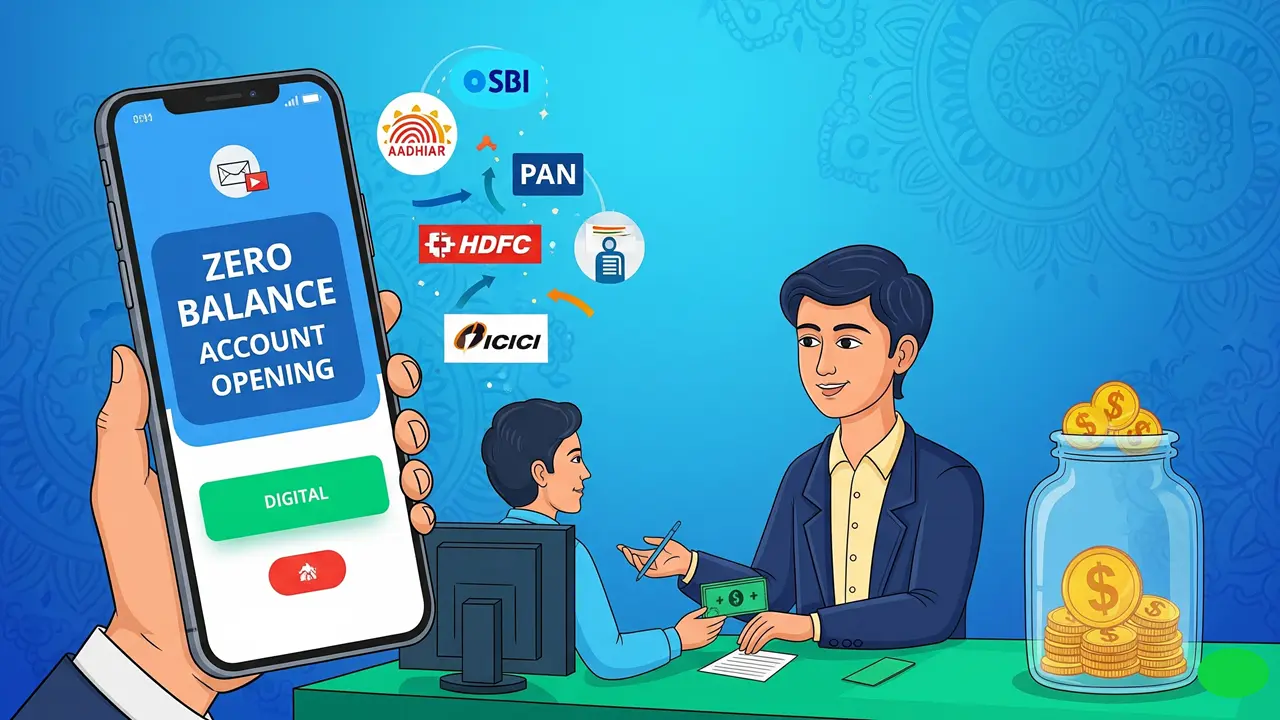Zero-balance accounts empower Indians to access banking without the burden of maintaining a minimum balance, making financial services inclusive for all. These accounts, often called Basic Savings Bank Deposit (BSBD) accounts, offer essential features like UPI and debit cards. From students in cities to farmers in villages, anyone can open one with minimal effort. This guide explains how to open a zero-balance account in 2025, providing a step-by-step approach for seamless banking.
What is a Zero-Balance Account?
A zero-balance account is a savings account that requires no minimum balance, eliminating penalties for low or no funds. Mandated by the Reserve Bank of India (RBI) under BSBD guidelines, these accounts include free services like ATM withdrawals and online transfers. They’re designed to promote financial inclusion across India. Banks like SBI, Kotak 811, and Axis offer these accounts with digital and offline access.
Business Loan
Get personal loan up to 5 CR
Home Loan
Get home loan up to 50 lakhs
Interest rates range from 2.75-7% p.a., depending on the bank and balance (RBI). Users can perform transactions like ₹50 UPI payments or ₹5,000 bill settlements without fees. These accounts suit irregular earners or those starting their financial journey. Zero-balance accounts are a gateway to banking freedom.
Why Open a Zero-Balance Account?
Zero-balance accounts remove financial barriers, making banking accessible for low-income or young users. Unlike standard accounts requiring ₹5,000-10,000 minimum balances, they incur no penalties, saving ₹100-300 monthly in fees. This benefits daily wagers or students with limited funds. They’re ideal for building financial habits.
These accounts integrate with India’s digital economy, supporting UPI and mobile banking. They also connect to government schemes like PMJDY, offering insurance and subsidies. Opening a zero-balance account ensures financial flexibility for all. It’s a practical choice for inclusive banking.
Benefits of Zero-Balance Accounts
Zero-balance accounts provide free access to essential banking services, including debit cards and UPI transactions. For example, Axis Bank’s Amaze account offers rewards like Amazon Prime membership without maintenance fees (Axis Bank). They include free NEFT/RTGS and digital statements. These features cater to diverse needs.
Accounts under PMJDY provide ₹1 lakh accident insurance and ₹30,000 life cover (ClearTax). They facilitate direct benefit transfers for rural users, like LPG subsidies. High interest rates, like Kotak 811’s 6% p.a., boost savings (Kotak 811). Zero-balance accounts combine affordability with value.
Who Can Open a Zero-Balance Account?

Aadhar Pe Loan
Get aadhar loan up to 1 lakhs
Personal Loan
Get personal loan up to 5 lakhs
Indian citizens aged 18 or above can open a zero-balance account, including salaried individuals, self-employed, or unemployed persons. Minors can open accounts under guardianship, like HDFC’s Kids Advantage Account. Non-residents (NRIs) may not qualify for BSBD accounts, needing NRE/NRO accounts instead. Eligibility is inclusive, with no income restrictions.
KYC compliance requires valid identity and address proof, like Aadhaar or PAN. Banks like SBI accept alternatives, such as voter ID, for flexibility (ClearTax). Rural users with limited documents can use PMJDY accounts. Meeting basic criteria ensures quick account setup.
Documents Needed
Opening a zero-balance account requires standard KYC documents for verification. Aadhaar and PAN cards serve as primary identity and address proofs. Alternatives like driving licenses, voter IDs, or utility bills work if PAN is unavailable, alongside Form 60. A passport-sized photograph may be needed for offline applications.
Digital copies of documents streamline online applications via Video KYC. For PMJDY accounts, Aadhaar alone may suffice in rural branches. Ensure documents are valid and clear to avoid delays. Proper documentation ensures a smooth process.
Step 1: Choose the Right Bank
Select a bank offering zero-balance accounts with features matching your needs. SBI’s BSBD account suits rural users with PMJDY benefits like ₹1 lakh insurance (ClearTax). Kotak 811 provides 6% p.a. interest and instant digital onboarding (Kotak 811). Compare banks like HDFC or Axis for rewards or accessibility.
Check branch or ATM availability, especially in rural areas, via bank websites like sbi.co.in. Digital-focused banks like IDFC FIRST offer unlimited withdrawals (IDFC FIRST Bank). Research ensures you pick a bank aligning with your lifestyle. The right choice enhances banking convenience.
Step 2: Apply Online with Video KYC
Most banks offer online account opening with Video KYC for instant activation. Download the bank’s app, like Axis Open or Kotak 811, from Google Play or App Store. Select the zero-balance account option and enter details like name, mobile number, and email. This process suits urban and rural users with internet access.
Upload digital copies of Aadhaar and PAN, then schedule a Video KYC call. A bank representative verifies your identity via webcam, taking 5-10 minutes. Receive your account number and virtual debit card instantly. Online applications are quick and paperless.
Step 3: Apply Offline at a Bank Branch
For offline applications, visit a nearby bank branch, like SBI or HDFC, with your documents. Request a zero-balance account form from the staff, ideal for rural users or those without smartphones. Fill out details like address and occupation accurately. In-person guidance ensures clarity.
Submit KYC documents, including Aadhaar, PAN, and a photograph, for verification. The bank processes your application within 1-3 days, notifying you via SMS. Collect your debit card or passbook later. Offline opening is reliable for traditional banking preferences.
Step 4: Link Aadhaar and Mobile Number
Link your Aadhaar and registered mobile number to the account for seamless transactions. This enables UPI setup via apps like BHIM or PhonePe for ₹100 payments. Banks verify Aadhaar via OTP sent to your mobile during KYC. Linking ensures digital banking functionality.
Update your mobile number with the bank if changed, via apps like SBI YONO. Aadhaar linkage supports government subsidies for PMJDY accounts. Ensure details match to avoid transaction issues. This step integrates your account with India’s digital ecosystem.
Step 5: Activate Digital Banking Services
Activate mobile banking and UPI through the bank’s app, like HDFC NetBanking or Kotak 811. Register with your account number and set a secure password or PIN. Enable SMS alerts for real-time updates on ₹50 spends or ₹5,000 deposits. Digital services enhance account usability.
Download UPI apps like Google Pay and link your zero-balance account for instant payments. Check NPCI’s website for compatible apps (NPCI). Explore net banking for NEFT or bill payments. These tools make banking efficient and accessible.
Popular Zero-Balance Accounts in India
SBI’s BSBD account offers free RuPay debit cards and PMJDY benefits, ideal for rural users (ClearTax). Kotak 811 provides 6% p.a. interest with ActivMoney and virtual debit cards (Kotak 811). Axis Bank’s Amaze includes cashback and rewards like Swiggy discounts (Axis Bank). These accounts cater to varied preferences.
HDFC’s BSBD account supports free online transfers and locker facilities (HDFC Bank). IndusInd Bank’s Indus Delite offers premium features with ₹10,000 initial funding, withdrawable later (IndusInd Bank). IDFC FIRST’s accounts provide high interest and insurance (IDFC FIRST Bank). Choose based on your banking needs.
Limitations to Understand
Zero-balance accounts may cap free transactions, like SBI’s 4 free ATM withdrawals monthly, with ₹20 fees thereafter (ClearTax). Maximum balances, like ₹50,000 in SBI’s tiny accounts, limit savings (HDFC Bank). Premium services, like high-limit loans, are unavailable. These restrictions suit basic banking.
Only one BSBD account is allowed per bank, per RBI rules, preventing multiple accounts at HDFC or SBI (RBI). Some banks impose dormancy fees if unused for years. Understand terms via bank websites to avoid surprises. Regular accounts may suit advanced needs.
Common Mistakes to Avoid
Don’t provide incomplete KYC documents, like an expired voter ID, as it delays activation. Ensure Aadhaar and PAN are valid before applying. Submitting mismatched details, like a different mobile number, causes rejections. Accuracy ensures a smooth process.
Avoid exceeding transaction limits unknowingly, incurring fees like ₹21 per extra withdrawal (ClearTax). Don’t open multiple BSBD accounts, violating RBI rules, risking closure. Check existing accounts before applying. These precautions prevent setbacks.
Tools to Manage Your Account
Bank apps like SBI YONO or Kotak 811 track ₹100 UPI spends or ₹5,000 transfers instantly. Enable transaction alerts via SMS or email for security. Use secure UPI apps like BHIM, endorsed by NPCI, for payments (NPCI). These tools simplify account management.
Install antivirus software on devices to protect against phishing or malware. Budgeting apps like Moneyview integrate with zero-balance accounts for expense tracking. Check bank websites for updates on features. Digital tools ensure secure, efficient banking.
Conclusion
Opening a zero-balance account in India is a straightforward way to access banking without minimum balance worries. With banks like SBI, Kotak 811, and HDFC offering online and offline options, anyone can start banking seamlessly. Follow these steps, leverage digital tools, and choose a bank that fits your needs. Begin your zero-balance account in 2025 for inclusive, stress-free banking.
FAQs
1. What is a zero-balance account?
It’s a savings account with no minimum balance requirement, offering free services like UPI, debit cards, and online transfers.
2. Who can open a zero-balance account in India?
Indian citizens aged 18+, including students or daily wagers, can open one with valid KYC documents like Aadhaar and PAN.
3. Which banks offer the best zero-balance accounts?
SBI, Kotak 811, Axis Bank, and HDFC provide zero-balance accounts with features like 6% interest or insurance.
4. Can I open a zero-balance account without visiting a bank?
Yes, banks like Kotak 811 and Axis Bank offer online opening with Video KYC in 5-10 minutes.
5. Are there any fees for zero-balance accounts?
They’re free of maintenance fees, but exceeding limits, like 4 ATM withdrawals, may incur charges like ₹20 per transaction.
